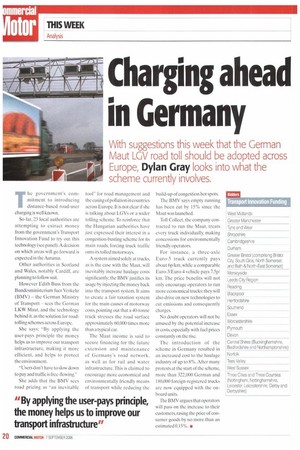Charging ahead in Germany
Page 20

If you've noticed an error in this article please click here to report it so we can fix it.
With suggestions this week that the German Maut LGV road toll should be adopted across
Europe, Dylan Gray loo(s into what the
scheme currently involves.
he government's commitment to introducing distance-based road-user charging is well known.
So far. 23 local authorities are attempting to extract money from the government's Transport Innovation Fund to try out this technology ( see panel). A decision on which areas will go forward is expected in the Autumn.
Other authorities in Scotland and Wales, notably Cardiff, are planning to follow suit.
However Edith Buss from the Bundesministerium fuer Verkehr (BMV) — the German Ministry of Transport — sees the German LKW Maut, and the technology behind it, as the solution for roadtolling schemes across Europe.
She says: "By applying the user-pays principle the money helps us to improve our transport infrastructure, making it more efficient, and helps to protect the environment.
"Users don't have to slow down to pay and traffic is free-flowing."
She adds that the BMV sees road pricing as -an inevitable tool" for road management and the easing of pollution in countries across Europe. It is not clear if she is talking about LGVs or a wider tolling scheme. To reinforce that the Hungarian authorities have just expressed their interest in a congestion-busting scheme for its main roads, forcing truck traffic onto its tolled motorways.
A system aimed solely at trucks, as is the case with the Main, will inevitably increase haulage costs significantly; the BMV justifies its usage by injecting the money back into the transport system. It aims to create a fair taxation system for the main causes of motorway costs, pointing out that a 40-tonne truck stresses the road surface approximately 60.000 times more than a typical car.
The Maut income is said to secure financing for the future extension and maintenance of Germany's road network. as well as for rail and water infrastructure. This is claimed to encourage more economical and environmentally friendly means of transport while reducing the build-up of congestion hot spots.
The BMV Says empty running has been cut by 15% since the Maut was launched.
Toll Collect, the company contracted to run the Maut, treats every truck individually, making concessions for environmentally friendly operators.
For instance, a three-axle Euro-5 truck currently pays about 6p/km, while a comparable Euro-3/Euro-4 vehicle pays 7.5p/ km. The price benefits will not only encourage operators to run more economical trucks; they will also drive on new technologies to cut emissions and consequently charges.
No doubt operators will not be amused by the potential increase in costs, especially with fuel prices constantly on the rise.
The introduction of the scheme in Germany resulted in an increased cost to the haulage industry of up to 8%. After many protests at the start of the scheme, more than 322,000 German and 180,000 foreign-registered trucks are now equipped with the onboard units.
The BMV argues that operators will pass on the increase to their customers, rasing the price of consumer goods by no more than an estimated 0.15%. •
































































































































































































